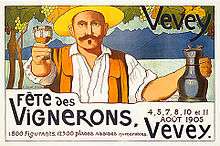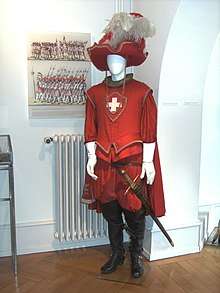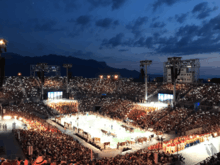Fête des Vignerons
The Fête des Vignerons (Winegrowers’ Festival) is a traditional festival which takes place in Vevey, in Switzerland.
| Fête des Vignerons | |
|---|---|
 Fête des Vignerons poster, 1905 | |
| Country | Switzerland |
| Reference | 01201 |
| Region | Europe |
| Inscription history | |
| Inscription | 2016 |
| List | Representative |
 | |
It has been organised by the Confrérie des Vignerons (Brotherhood of Winegrowers) in Vevey since 1797. The organising committee is free to choose how often the festival takes place, but the maximum number of times is five times in a century. Up to now, the interval between two festivals has varied between 14 and 28 years. The most recent festival took place in July and August 2019, 20 years after the preceding one (1999).
The festival features a show celebrating the world of winemaking; many performances take place in the marketplace near the shore of Lac Léman, and festivities also take place in the town itself. Since 2016, the Fête des Vignerons has been included in UNESCO's intangible cultural heritage.[1]
The 2019 edition of the festival is recommended as one of National Geographic's "world's most exciting destinations",[2] one of The New York Times's "places to go in 2019"[3] and is listed in The Guardian's "Where to go in 2019" list.[4]
History
Origins
The oldest object attesting to the existence of the Confrérie des Vignerons (Brotherhood of Winegrowers), a cup, dates from 1618. The Abbots-Presidents (presidents of the Council of the Brotherhood) are most often notables, members of the City Councils, lawyers, notaries or judges.
At the end of the 18th century, the Brotherhood, which was then composed of bourgeois landowners, decided to reward the work of the most deserving winegrowers. While at that time it was more common to reprimand negligent and lazy people, they decided to value the efforts made to improve farming methods. Experts of the Brotherhood note, judge and classify the winegrowers. Thus was to be born a ceremony of coronation of the best workers who are at the origin of the celebration. It then took place in the form of a procession.
In 1797, on the Place du Marché in Vevey, a platform with two thousand seats was erected. Under the chairmanship of Abbot-President Louis Levade, this first show was held on August 9, 1797.[5] In order to enhance the ceremony, a show is created consisting of a procession and a theatrical performance divided into four seasons presided over by the pagan deities, Pales, Bacchus and Ceres.
19th century

Due to the unrest of the Vaudoise Revolution, then the Napoleonic Wars, the following years did not allow for a new celebration. It would take twenty-two years, in 1819, for a new celebration to be organized. The cycle is now created. The 1819 celebration took place from August 5 to 6 under the chairmanship of the same Abbot-President as the previous one. About 730 actors and performers participated in a 2000-seat arena. As the canton of Vaud recently joined the Confederation, the theme of this first 19th century celebration glorifies tradition and patriotism (the "Ranz des vaches" is sung for the first time).
The third Fête des vignerons took place from 8 to 9 August 1833 under the direction of Abbot-President Vincent Doret. About 780 actors and performers participated in a 4000-seat arena under the direction of dance master David Constantin, on a music written by Samuel Glady (in addition to songs from the traditional repertoire, this edition is the first to feature an original composition) and in costumes designed by Theophile Steinlen.[6]
In 1851, the fourth Fête des vignerons was held from 7 to 8 August under the direction of the Abbot-President François Déjoux. It is the first celebration whose music is entirely composed for the occasion (by François Grast) and thus forms a stylistic unity.[7] About 900 actors and performers participate in an 8,000-seat arena under the direction of the director Benjamin Archinard. This is the first time that the Ancients Swiss troop, previously intended to supervise the procession, marched.
It is also François Grast who composed the music for the next Fête des vignerons, which took place from 26 to 27 July 1865 and was conducted by the Abbot-President Louis Bonjour. About 1200 actors and performers participated in a 10,500-seat arena under the direction of the dancing master Benjamin Archinard, as at the previous festival, and Pierre Lacaze (costumes and staging). As the celebration grew, it was in deficit and had to rely on a public subscription for one third of its budget.[8]
From August 5 to 9, 1889, the sixth Fête des vignerons was held under the direction of the Abbot-President (and former President of the Confederation) Paul Ceresole. On this occasion, the show is staged by Ernest Burnat on the music of Hugo de Senger and brings together 1379 actors and performers in a 12,000 seat arena. This is the first time that the Ranz des vaches has been performed by a soloist, Placid Curtat, and not by a choir of armaillis.[9] The highly acclaimed performance of the soloist shows the symbolic function of this song in the festival and establishes the close link between Vevey and the heights of the Veveyse District and the Gruyère District.
20th century

The seventh Fête des vignerons took place from August 4 to 9, 1905. Under the direction of the Abbot-President, the radical national councillor Emile Gaudard, it was directed by René Morax (also author of the libretto) on music composed by Gustave Doret. It is the first celebration to owe its booklet to only one person and is distinguished from the previous ones by the fact that the procession becomes a secondary element. It is also the first celebration not to restrict the participation of women and girls.[10] About 1,800 actors and performers participated in an arena with 12,500 seats.
From August 1 to 9, 1927, the eighth Fête des vignerons was held under the direction of the same Abbot-President as the previous one, Emile Gaudard, then Switzerland's delegate to the League of Nations.[11] The production is directed by Edouard Vierne (René Morax declined the invitation), replaced by A. Durec a few weeks before the event, while the music is composed as at the previous celebration by Gustave Doret and the libretto by Pierre Girard.[12] About 2,000 performers participated, gathered in a 14,000-seat arena inspired by a medieval city surrounded by a wall and towers.
In 1955, the Fête des vignerons took place from August 1 to 15 under the direction of the Abbot-President David Dénéréaz. In a context of increasing entertainment possibilities, barely a decade after the end of the Second World War, the organisation became more professional: it was the first festival to have an international focus,[13] more than doubling its capacity compared to the previous one (the first performances were not entirely complete, but additional ones were organised following their success). The show was directed by Oscar Eberlé on a music by Carlo Hemmerling and a libretto by Géo H. Blanc. 3,850 performers participated in a 16,000-seat arena. The 1955 edition was the first to organize night performances.
From July 30 to August 14, 1977, the tenth Fête des vignerons was held under the direction of the Abbot-President Philippe Dénéréaz. It was directed by Charles Apothéloz on a music by Jean Balissat and a libretto by Henri Debluë. The sets and costumes were designed by Jean Monod. 4,250 performers participated in a 15,776-seat arena organized around a large solar clock with four cardinal points indicating the four seasons.[14]
The 1999 Winegrowers' Festival took place from July 29 to August 15. Presided over by the Abbot-President Marc-Henri Chaudet, it was directed by François Rochaix on a music by Jean-François Bovard, Michel Hostettler and Jost Meier. The libretto was by François Debluë (nephew of the 1977 librettist Henri Debluë) while Jean-Claude Maret directed the scenography and Catherine Zuber the costumes[15]. The show featured "Arlevin", a winemaker representing the crowned winemakers (the coronation only took place during the first performance).[16] 5,050 performers participated in a 16,000-seat arena. On August 11, the audience was able to see, during the show, the only total solar eclipse of the decade.
- Models of amphitheatres from the second half of the 20th century
- 1955
- 1977
- 1999
21st century

On December 1, 2016, the Fête des Vignerons was added to UNESCO's Representative List of the intangible cultural heritage of Humanity. It is the first Swiss tradition to be included.
The twelfth Fête des Vignerons was held from July 18 to August 11, 2019. It was presided over by Abbot-President François Margot[17] and was directed by Daniele Finzi Pasca.[18] The music was composed by Maria Bonzanigo (musical director), Jérôme Berney and Valentin Villard, while the libretto was the work of Stéphane Blok and Blaise Hofmann[19]. The scenography was by Hugo Gargiulo,[20] Bryn Walters was the choreographer and the costumes were designed by Giovanna Buzzi. Among the approximately 6,000 actors and performers, there were nearly 1,000 singers (local choirs, choir-percussionists, children)[21] conducted by Caroline Meyer and Céline Grandjean[22] in an arena of 20,000 seats.[23] The traditional song Ranz des Vaches was performed by eleven armaillis[24] (traditional cow-herdsmen[25]), rather than a soloist as had been done since 1889.
The 2019 spectacle traced the activities of winegrowers through the seasons, seen through the eyes and imagination of a small girl called "petite Julie". The opening scene is set during the grape harvest. Julie's grandfather is playing cards and drinking wine outside a winegrowers' hut (locally known as a "capite"[26]). During the spectacle, Julie's grandfather teaches her about the mysteries of grapevines, the beauty of the landscape and the culture of wine-making. She repeatedly encounters the Three Doctors, clownish local worthies and experts of the Fête. Reality is transformed into a dreamlike fairy world through Julie's imagination and she is accompanied on her adventures by a beautiful dragonfly[27].
References
| Wikimedia Commons has media related to Fête des Vignerons. |
- "La Fête des vignerons de Vevey (UNESCO description)". UNESCO. Retrieved 6 November 2017. See also: "La Fête des vignerons de Vevey (UNESCO description)". UNESCO. Retrieved 6 November 2017.
- "Where to travel in 2019". National Geographic. 2018. Retrieved 4 May 2019.
- "52 Places to Go in 2019". The New York Times. 2019. Retrieved 4 May 2019.
- "Where to go on holiday in 2019 – the hotlist". The Guardian. 2018. Retrieved 4 May 2019.
- http://www.24heures.ch/vaud-regions/riviera-chablais/1797-fete-succede-parade/story/24509569
- "8 - 9 août 1833 : La Fête pour une nouveau public". Confrérie des Vignerons.
- "7 - 8 août 1851 : Une partition originale pour la Fête des vignerons". Confrérie des Vignerons.
- "26 - 27 juillet 1865 : Un financement de plus en plus difficile". Confrérie des Vignerons.
- "5, 6, 8 et 9 août 1889: L'Alpe au centre de la cité". Confrérie des Vignerons.
- "4, 5, 7, 8 et 9 août 1905: Un jeu unifié". Confrérie des Vignerons.
- "Patrie et festival". The Swiss Observer. 3 September 1927.
- "1er - 9 août 1927: Le repli esthétique". Confrérie des Vignerons.
- "1er - 14 août 1955 : Le légendaire messager conquiert la Suisse". Confrérie des Vignerons.
- "30 juillet - 14 août 1977: La symbolique chrétienne". Confrérie des Vignerons.
- Imsand, Marcel. (1999). Fête des vignerons Vevey 1999 : livre-souvenir officiel. Pache, Philippe., Salem, Gilbert., Jeker, Werner., Fête des vignerons (1999 : Vevey). Lausanne: 24 Heures. ISBN 2-8265-1128-9. OCLC 78427850.
- "1999: "Amour et joie" sur la Grande place et dans la ville". Confrérie des Vignerons.
- L'équipe de la Fête des Vignerons 2019 est connue, on 24heures.ch
- Le concepteur de la Fête des Vignerons a été designé, on LaLiberte.ch
- Sàrl, Ergopix (2018-12-11). "Les auteurs". Fête des Vignerons 2019 (in French). Retrieved 2020-03-29.
- Un nouveau scénographe annoncé lors de la présentation de l'arène, on 24heures.ch
- Les chœurs, voix de la vigne, on 24heures.ch, Octobre 12, 2018.
- Fête des Vignerons: Le Chœur de la Fête bat deux fois au féminin, on 24heures.ch, March 28, 2019.
- La future Fête des vignerons de 2019 dévoile son arène de 20 000 places, on rts.ch.
- Maspoli, Philippe (2018-05-28). "Onze voix pour le "Lyoba" de la Fête". 24Heures (in French). ISSN 1424-4039. Retrieved 2020-03-29.
- swissinfo.ch, S. W. I.; Corporation, a branch of the Swiss Broadcasting. "Que sont devenus les armaillis". SWI swissinfo.ch (in French). Retrieved 2020-03-29.
- swisswine (2016-07-23). "Vignobles ! Capites ou guérites ?". Swiss Wine (in French). Retrieved 2020-03-29.
- Carruzzo-Frey, Sabine, 1957- (2019). Le livre du spectacle : Fête des Vignerons 2019. Finzi Pasca, Daniele., Favrod, Guillaume., Genoud Arts Graphiques). Vevey: Confrérie des Vignerons. ISBN 978-2-8399-2684-3. OCLC 1119703470.CS1 maint: multiple names: authors list (link)